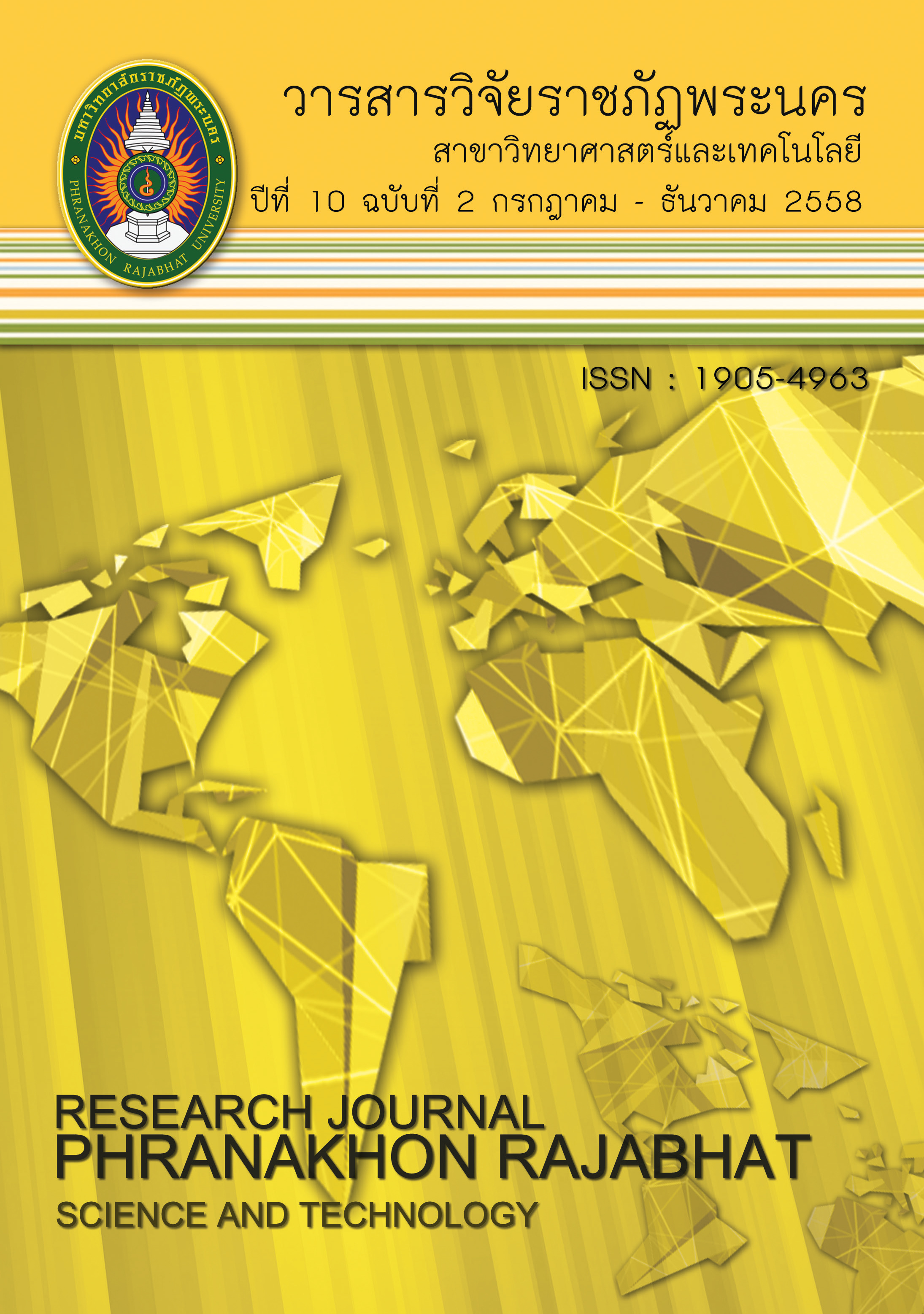การใช้ร่มเงาพรรณไม้เพื่อลดอุณหภูมิของกรอบอาคาร
Keywords:
พรรณไม้ยืนต้น, ร่มเงาพรรณไม้, อุณหภูมิอากาศ, กรอบอาคาร, Trees, Shade trees, Air temperature, Building envelopeAbstract
การวิจัยศึกษาประสิทธิภาพร่มเงาของพรรณไม้ เพื่อนำมาใช้ประโยชน์ในการลดค่าการถ่ายเทความร้อนรวมของกรอบอาคาร ส่งผลให้เกิดการประหยัดการใช้พลังงานของอาคาร มีวัตถุประสงค์เพื่อสร้างองค์ความรู้ในการใช้ประโยชน์จากร่มเงาพรรณไม้ยืนต้นที่เหมาะสม เพื่อลดค่าการถ่ายเทความร้อนรวมของกรอบอาคารอย่างมีประสิทธิภาพ ขอบเขตของการวิจัย เน้นการสำรวจเก็บข้อมูลด้านพรรณไม้ยืนต้นและวัดข้อมูลสภาพอุณหภูมิอากาศของอาคารกรณีศึกษา คือ อาคาร 12 ศูนย์วัฒนธรรมพระนคร มหาวิทยาลัยราชภัฏพระนคร ที่มีสภาพแวดล้อมพรรณไม้ยืนต้นหนาแน่นรอบบริเวณอาคาร เพื่อทดลองและวิเคราะห์ศักยภาพพรรณไม้ด้านอิทธิพลของร่มเงาเพื่อการบังแดดให้กับอาคาร การวิเคราะห์ค่าการถ่ายเทความร้อนรวมของกรอบอาคาร (OTTV) และสรุปผลประสิทธิภาพร่มเงาพรรณไม้และประเมินค่าการประหยัดพลังงานของอาคาร ตัวแปรที่ใช้ในการวิจัย คือ 1) ลักษณะของพรรณตามสภาพแวดล้อมของอาคารกรณีศึกษา ประกอบด้วย ชนิดของพรรณไม้, ขนาดพรรณไม้, การให้ร่มเงา (Shade) และ 2) ค่าการถ่ายเทความร้อนรวมของอาคาร ทั้งนี้ ประโยชน์ที่คาดว่าจะได้รับก็เพื่อสร้างองค์ความรู้ในการใช้พรรณไม้ที่เหมาะสม บังแดดและให้ร่มเงากับอาคาร ซึ่งจะส่งผลต่อการประหยัดพลังงานในอาคารและสามารถให้คนทั่วไปนำไปใช้ประโยชน์อย่างเป็นรูปธรรมผลการวิเคราะห์ พบว่า พรรณไม้ยืนต้นรอบอาคาร 12 ศูนย์วัฒนธรรมพระนคร มีศักยภาพสูงสุดสามารถป้องกันมุมโปรฟายส์ของดวงอาทิตย์ที่มีผลกระทบต่อผนัง ในช่วงเวลา 8.00 น. ถึง 18.00 น. ตลอดทั้งปีนั้น ขึ้นอยู่กับปัจจัยที่สำคัญ คือ 1) การกำหนดทิศทางการปลูก และ 2) กำหนดระยะการปลูก ที่สัมพันธ์กับทิศทางของผนังอาคาร และสรุปได้ว่าอุณหภูมิอากาศที่ทดลองวัดค่าจากผนังอาคารทิศตะวันตกเฉียงใต้ (SW) ไม่ได้มีอุณหภูมิอากาศในระดับสูงตามผลจากการคำนวณค่าการถ่ายเทความร้อนรวมของกรอบอาคารที่ได้แสดงผล แต่พบว่าการที่อุณหภูมิอากาศตํ่ากว่าค่าคำนวณการถ่ายเทความร้อนรวมของกรอบอาคาร เป็นผลจากอิทธิพลจากค่าสัมประสิทธิ์การบังเงาของพรรณไม้ยืนต้น ซึ่งไม่มีกำหนดไว้ในโปรแกรมคำนวณค่าการถ่ายเทความร้อนรวมของกรอบอาคาร นับเป็นค่าสัมประสิทธิ์การบังเงาของต้นไม้ ที่เกิดจากความหนาแน่นของพุ่มใบเป็นอิทธิพลร่มเงาพรรณไม้เพื่อลดอุณหภูมิกรอบอาคาร (สุนทร บุญญาธิการ. 2542) เป็นตัวแปรสำคัญในการควบคุมรังสีความร้อนจากดวงอาทิตย์ ซึ่งขึ้นอยู่กับประสิทธิภาพการบังเงา แสดงด้วยค่า S.C. (Shading Coefficient) จากอิทธิพลของพรรณไม้ ที่มีขนาดความสูงและความกว้างของพุ่มใบ มีการกำหนด 1) ทิศทางการปลูก และ 2) ระยะการปลูก ทำให้ให้เกิดประสิทธิภาพร่มเงาของพรรณไม้ สามารถนำมาใช้ประโยชน์ในการลดค่าการถ่ายเทความร้อนรวมของกรอบอาคาร ส่งผลให้เกิดการประหยัดการใช้พลังงานของอาคาร
The researchers studied the shade of trees. To be useful in reducing the heat of the building. As a result, the savings in energy consumption of the building. The objective is to build knowledge in the use of shade tree species appropriate to reduce the heat transfer efficiency of the building. Scope of Research The survey collected information on the tree species and measured data of temperature of the case study is building 12 (PCC) phranakhon rajabhat university. The perennial plant environment around the building. For testing and analyzing the potential of plants to suit the influence of shade to shade the building, an analysis of the heat transfer of the building, the performance shade trees and estimated energy savings. Building. The variables used in this study were 1) the nature of the vegetation surrounding the case study include species of trees, large trees, the shade (Shade) and 2) the heat of the building (OTTV). The benefits expected to be received. Is to build knowledge of the appropriate species. Sun and shade the building. Which will result in energy savings in buildings and the public can take to benefit substantially. The results showed that the tree species with the highest potential. Can prevent the pro RECEIVERS The sun’s effect on the wall during 8.00 am. To 18.00. Throughout the year, based on the two key factors: 1) the direction to grow and 2) set to grow. Relative to the direction of the facade. And concluded that the experimental temperature measurements from the SW wall of the building does not have a temperature as high as a result of the calculation is OTTV display. However, the air temperature is below the calculated OTTV as a result of the influence of shading coefficient of species. Which is not defined in the program calculates the OTTV. For the shading coefficient of the tree. Caused by the density of the leaves. The influence shade trees to reduce the temperature of the building. This was an important factor in controlling the heat from the sun. Depending on performance, indicated by the shading SC (Shading Coefficient) the influence of vegetation. The height and width of the leaves. And are 1) the direction to grow and, 2) the planting could be effective shade of trees. That can be utilized to reduce the heat of the building. As a result, the savings in energy consumption of the building.
Downloads
Issue
Section
License
โปรดกรอกเอกสารและลงนาม "หนังสือรับรองให้ตีพิมพ์บทความในวารสารวิจัยมหาวิทยาลัยราชภัฏพระนคร สาขาวิทยาศาสตร์และเทคโนโลยี" ก่อนการตีพิมพ์



